YOU ARE HERE >> AmazingRibs » Ratings & Reviews » Ratings Reviews And Buying Guides » Ratings & Reviews Of Hundreds Of Grills Smokers Hog Roasters And More » The Delta By Nuke Review
The Delta By Nuke Review
All of our reviews are done independently by our team of testers and are in no way influenced by advertising or other monetary compensation from manufacturers. Click here to learn more about our unbiased product review process.
Published On: 5/21/2020 Last Modified: 10/28/2025

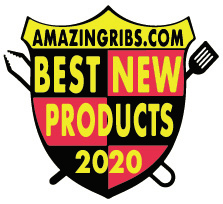
An Affordable Argentine Wood Grill With Style To Spare
The Delta by Ñuke is an Argentine-style wood grill with minimal parts and maximum fun. It’s a rectangular, brick-lined firepit with a grill grate on the left, a firebox on the right for lighting wood or charcoal, and not much else. The adjustable-height grill grate provides a generous 547 square inches of grilling area and the firebox is perfectly sized for firing up a few wood splits at once. Directly below the brick-lined pit, the Delta also features a handy “warming drawer” that doubles as a storage drawer for the provided fire poker, coal shovel, and carbon steel plancha (griddle). It also comes with a rain cover.


Ñuke sells the Delta with a rolling cart that positions the floor of the firepit just above counter-height (37 inches). This makes it very easy to stand at this grill, adjust the coals, and cook to your heart’s content. You can also buy the Delta as a drop-in unit for outdoor or indoor kitchens. If you like playing with fire as much as you do playing with food, you’ll love cooking on the Delta.
Al Asador And A La Parrilla
This grill is built for the hands-on style of outdoor cooking favored in Argentina, where gauchos on the pampas (South American cowboys on the plains or “Delta”) would rustle up amazing whole animal dinners with little more than knives, a campfire, some metal stakes, and their bare hands. There are two main styles of Argentine woodfire cooking. The first, “al asador,” centers around a bonfire, where the meat is usually a whole animal carcass splayed open and skewered on the “asador,” a metal cross. The entire animal is then propped up near the raging fire, where it slowly roasts as the gaucho rotates it now and then for even heating. An entire cattle split open and propped near a raging fire is quite an impressive sight. Once the logs have burned down to embers, a second type of cooking takes place “a la parrilla,” on the grill.
The modern parrilla
The Delta by Ñuke is essentially a modern parrilla. For this style of Argentinian cooking, you scrape the embers under the grill grate for cooking smaller cuts like steaks, sausages, chicken, sweetbreads, kidneys, or whatever else you like. You control the heat with the thickness of your coal bed and by raising or lowering the grill grate. That’s pretty much all the temperature control you get.
Modern Argentine grilling is fairly primitive by Northern American standards, where thermostats, wireless remote controls, auto shut off, and other conveniences stand at the forefront of set-it-and-forget-it barbecue technology. And that’s the beauty of this thing. Argentine grilling is a pyromaniac’s playground. It takes some skill to control a wood fire with only a poker and shovel and then properly cook a satisfying meal. It can be a challenge at first, but it is remarkably rewarding once you get the hang of it. For total pyros like me, it’s pure pleasure to cook on the Delta.
Like what you’re reading? Click here to get Smoke Signals, our free monthly email that tells you about new articles, recipes, product reviews, science, myth-busting, and more. Be Amazing!
Construction
The Delta is constructed of medium-gauge painted steel, and the entire firepit is lined with refractory bricks or “fogonero.” The bricks are 8 3/4 x 4 3/8 x 5/8-inch thick and retain radiant energy from the coals, helping to deliver steady heat to your food, sort of like a giant baking stone that goes up the sides of the firepit as well.
On the right side of the grill, the firebox measures about 8 x 15 inches with a heavy-duty sliding steel cradle for holding wood splits.
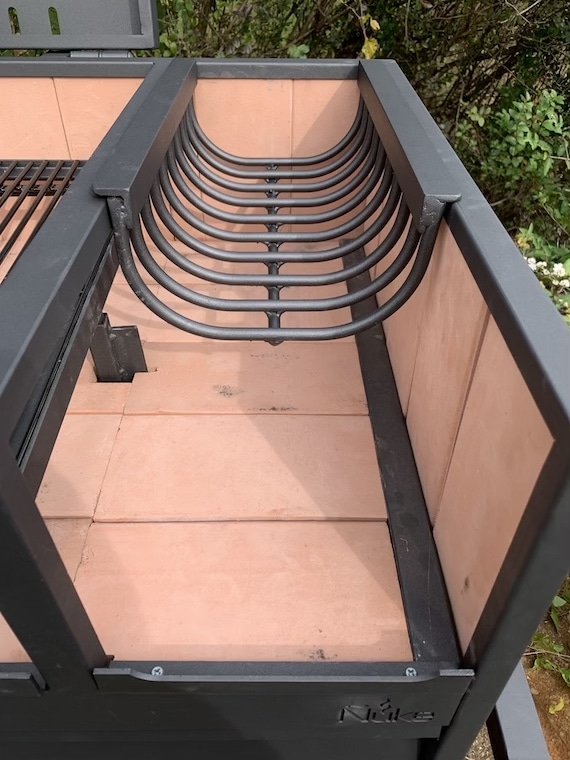
Adjustability
The cradle has thick, wide bars and is geared toward lighting logs, but it’s also completely removable, so you could light charcoal briquets if you like. You can also set the supplied carbon steel griddle (a.k.a. “plancha” or “chapa”) right over the cradle for searing cut vegetables, shrimp, or smaller, quick-cooking foods. Or set a cast-iron skillet there, or even a wok. If you want raging heat under your food, this is the spot for it.
To the left of the firebox, the grill grates cover the rest of the cookbox and fit into a height-adjustable frame. The frame has five positions from the highest, about 7 inches off the firepit floor, down to about 3 3/4 inches off the floor. You adjust the height with a simple crank arm and thumb-lock system on the left side of the Delta.

There’s just over 3 inches of adjustability, which may not seem like much, but proved to be effective for searing thin steaks right near the coals and slow cooking thicker cuts further away. The height-adjustable grate is one of this grill’s most versatile features and one the primary methods of heat control.
Surface design
The entire grill surface is actually split: two separate grates rest in the frame, each measuring 12 1/2 inches wide by 21 inches deep. Theoretically, you could remove one of the grill grates if you wanted to put more coals in that space and close the lid for some semblance of two-zone cooking. But the Delta’s lid does not completely cover this grill. Even with the lid down, the Delta is still open on the firebox side and in the front, so you can’t really use this grill as an outdoor oven like many other grills with lids. That said, the lid does help direct some heat back down onto the grill, so you can melt cheese on the top of burgers or pizza. It can also help keep wind at bay.
The grates themselves are constructed of round rods made of porcelain coated steel. I generally prefer uncoated stainless steel grates because porcelain chips and slows down heat transference (read more here about why we prefer stainless steel grill grates), but performance has not been an issue thus far. The bigger question is: why aren’t these grill-grates V-shaped? V-grates are a signature feature of many Argentinian style grills, typically set on a forward-sloping angle to catch grease and meat juices then direct them away from the fire, preventing flareups. V-grates usually channel the fat and juices into a tray or pan so you can also use them for basting, to make a sauce, or just to pour the “au jus” over the meat.
Statements from Ñuke
So we asked the manufacturer, “Why didn’t you include V-grates on the Delta?” Here’s the response from ÑukeBBQUSA:
“That’s a big ol’ can o’ worms right there. Let me tell you why. My partners, the owners of Ñuke in Argentina, Jorge and Marcos Dartiguelongue, are father and son. One of them (the father) insists that V grates are better for just the reasons you mention. Marcos, on the other hand, insists that the V grates are messy, as you have collect the fat and that the space in between the V actually steams the beef. He prefers that the fat falls on the bricks and that the vapors infuse the beef. Marcos won the argument as far as the Delta, but Jorge (and me) won when it comes to the high end model being launched at HPBA [the annual Hearth, Patio, and Barbecue Association industry expo]. I am referring to the Puma, which by the way was named after the Argentine Rugby team. Jorge was on the national team in the 1970s.”
Our response
There you have it. But is it really Argentine grilling on the Delta without the angled V-grates? Apparently so. It’s good enough for Argentina’s most famous outdoor chef Francis Mallman, who also decided on round rods for his “Mallmann’s Grill” manufactured by Best Made. And like I said, the round rods have not been an issue in my cook tests. I have had zero problem with flare-ups while cooking burgers, steaks, and other fatty meats. If you really want V grates so you can catch the fat and juices for basting and saucing like a gaucho, look for Ñuke’s higher-end “Puma” model coming soon.
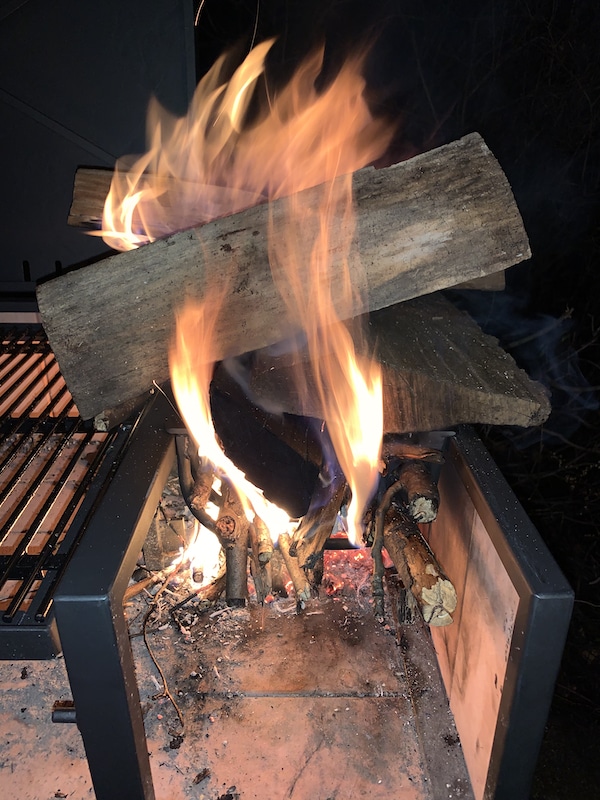
Firing Up
Have you ever lit a fire in a fireplace? Then you know how this goes. Set your logs on the Delta’s metal cradle (a.k.a. “brasero”) with some kindling and a fire starter beneath it. Then let’r rip. You could also place lit charcoal briquets right on the firebricks, but the Delta has no dampers, so controlling the burn of briquets is a bit trickier.
Nuke really designed The Delta for wood logs. I tried a few different standard log-lighting methods, including the teepee method, log cabin method, and just stacking the pieces in the same direction in the cradle (read more here on how to light a wood fire). I even pre-lit some splits in my stickburner, which has a propane log lighter, then transferred the burning logs to the Delta. And I tried lighting a couple chimneys of briquets to use as the firestarter, then put the logs over the lit charcoal. All of these methods worked reasonably well, but I liked the log cabin method the best.
The brasero is long and narrow, so it’s best to line it first with small and then with larger twigs and branches, and then a log or two on top, leaving some airspace for oxygen to feed the fire. Put your fire starter beneath that (crumpled newspaper works great), light it, and let it go. In my tests, this fire set up got the most fuel burned in the shortest amount of time so I could start cooking. The supplied shovel and coal rake helped with managing the fire, but you may want a set of log tongs to fiddle with the lit logs for optimal burning. I use a set of really sturdy grill tongs.

Fuel efficiency
I hope you like burning wood because the Delta blazes through a lot of it. Compared to a kamado or pellet cooker, some might call the Delta “inefficient.” But that misses the point of gaucho style grilling. Burning wood is the big draw here! Think of it like lighting a bonfire for sitting around in the backyard: you light this thing up in part just to look at the fire and enjoy the heat it gives off. It will take around a half-dozen splits or more to get a decent bed of embers for cooking, and that amount of wood takes time to burn. Give yourself at least 45 minutes to “preheat” this baby before you even think about putting food on it.
That preheat time also gives the fire bricks a chance to warm up the entire cooking chamber is preheated and ready to go. And that’s another reason why the Delta is not as great a cooker in cold weather. The firebricks help retain heat, but in the winter they’re constantly battling the ambient temperature. Believe me, I tested the Delta through December and January in the northeast, where evening temps were below freezing. Sure, you can cook on it then, but the Delta is a much better summer cooker. After all, the Pampas around Buenos Aires rarely gets below 40°F.
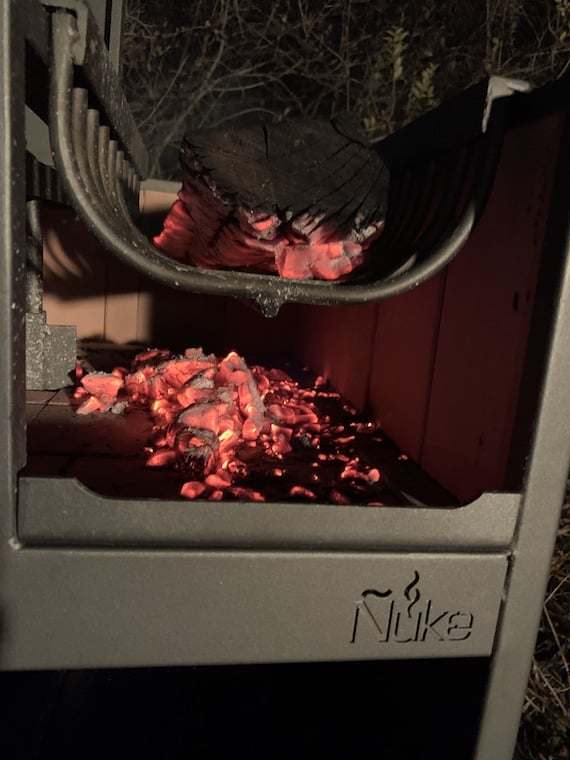
Heat Control
Once a big pile of coals has fallen through the log cradle, just scrape the embers to the left under your grill grate. Preheat the grates for a few minutes and you’re ready to roll.
Cooking on the Delta is very much like cooking in a fireplace with an adjustable-height grill grate. There are no dampers to control the airflow. The Delta’s lid does trap a little heat, but otherwise, heat control is largely up to you.
Tips for your desired heat level
For low heat, scrape a thin bed of coals under the grill grate and raise the grill up to its highest position. For high heat, make a thicker coal bed of and lower the grate so the food sits just above the glowing embers. To get even heating across the entire grill, scrape the coal bed as evenly as possible. You could even scrape coals into a ring that’s empty in the middle and place your food in the center to surround say, a thick beef roast, with even heat. And if you’re looking to get some semblance of 2-zone cooking with higher heat on one side and lower heat on the other, make a thick coal bed near the firebox on the right and a thin coal bed on the left.
We usually talk about 2-zone cooking as a horizontal cooking method like this, where you concentrate the heat on one side of the cooker for direct radiant heating, and leave the other side unheated for lower heat, indirect convection cooking. But with the Delta, it’s best to think vertically. Use the height adjustment to raise the meat further from the heat, and that allows you to do more gradual lower-heat cooking for thicker, tougher cuts. In gaucho-style grilling the “indirect” zone is simply higher up and further away from the heat. You have to baby the meat a bit more and turn it for even cooking, but it works.
Some issues
Unlike a kettle grill or gas grill with a lid, you cannot close the Delta completely. Even with the lid down, the cookbox is still open at the front and on the firebox side, so heat and smoke escape pretty easily. The Delta is not an outdoor oven. However, maintaining a thin coal bed and raising the grate as high as it can go does allow you to harness indirect grilling for thicker cuts and roasts that take longer to cook.
Some other height-adjustable grills allow you to split the cooking surface so that one side can be raised higher or lower than other. That’s helpful when you’re cooking, say, bone-in chicken, boneless steak, and asparagus at the same time. But the Delta doesn’t have split grate levels: The entire grill surface raises and lowers at once. No big deal. You can still adjust the depth of your coal bed in different spots to cook different foods at once. And you can put quick-cooking foods on the grill later when the longer-cooking ones are almost done. As with most campfire cooking, heat control is just a little less precise with the Delta. It’s a more primitive, hands-on style of cooking because the device does less of the work for you. And that’s one reason why fans of Argentinian grills love it. Including me.
Want a new set of tools? Check out Meathead’s new book, The Meathead Method. It’s a toolbox that will elevate all your cooking. Alton Brown calls it “The only book on outdoor cookery you’ll ever need.”
Sparks Will Fly
This cooker is not ideal for wooden decks. Would you build a campfire right there on your deck? Didn’t think so. The ideal spot for this cooker is a concrete patio or a sandy or grassy spot in a backyard, preferably with some wind protection. The firepit is open in the front, like a fireplace, so if the wind picks up, sparks will fly. During my tests, quite a few embers flew out of the firebox and onto the ground. One even landed on the wooden shelf of the Delta’s rolling cart without me noticing it. The next day I saw a big burn mark.
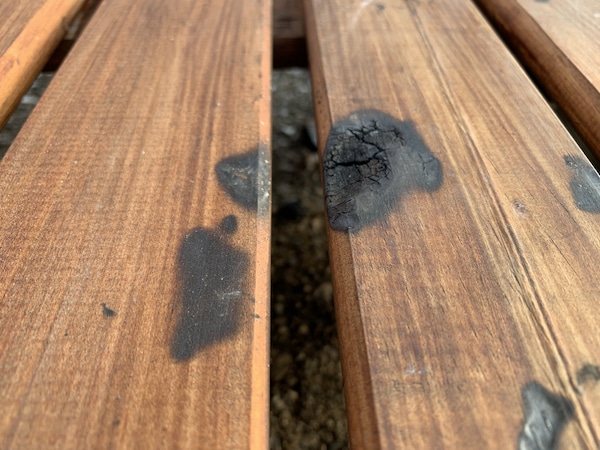
Word to the wise: keep the Delta away from any fire hazards such as dry leaves. And be especially careful during the initial fireup when the logs are getting going. A grill mat may be advisable. Here are some nice ones available from Amazon.
Argentinian Barbecue
Unlike most North American barbecue, Argentinian barbecue a la parilla is not really smoky. Once your logs burn down to glowing embers, there is very little smoke and much of it escapes to the air. You can taste a little in the meat, but it’s subtle. Nonetheless, low and slow is still the name of the game here. The even bed of glowing coals and the adjustable height grate allow you to slowly cook everything from sausages and beef hearts to thick, juicy cowboy ribeyes.
The intense radiant heat of the embers creates exceptional browning and flavor on meats, particularly on beef. This style of open-air cooking also allows for lots of evaporation, creating an extra thick, crispy crust on the meat. Keep your seasonings simple so you can really taste these signature elements. Just salt and pepper will do.
Beef takes center stage in Argentinian barbecue. Any and all kinds of offal (achuras) are usually grilled first. Sweetbreads (mollejas) and sometimes kidneys (riñones) or intestines (chinchulines) are cooked a la parilla until crisp on the surface then served with just a squeeze of lemon. The first course may also include some grilled blood sausage or chorizo sausage and a slab or two of provoleta, grilled provolone-style cheese. You share all of these dishes among everyone at the table.
Then comes the real star: Thick slabs of slow-cooked beef with a dark mahogany crust seasoned only with coarse salt. In Argentina, side dishes are considered nothing but garnishes (guarniciones) and may consist of a simple vegetable salad or maybe some potatoes. The preferred barbecue sauce is chimichurri or perhaps salsa criolla, a mix of chopped red peppers, tomato, onion, parsley, oil and vinegar, served at the table to be used sparingly at the diner’s discretion.
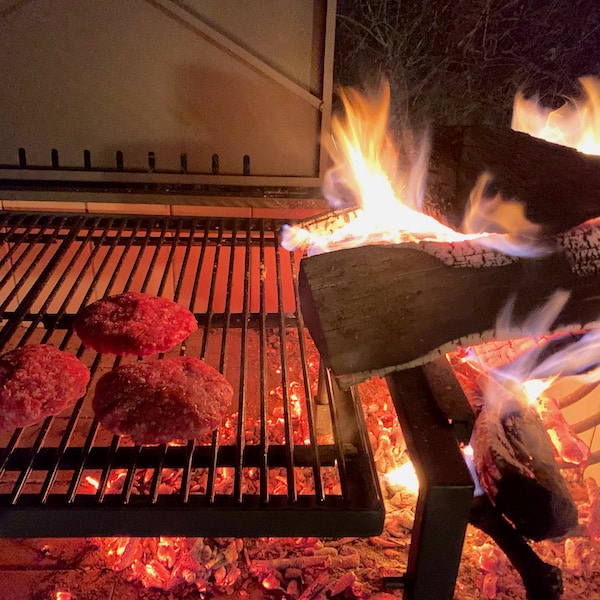
Cook Tests
As much as I love the steaks and sausages of Argentinian barbecue, I figured I should start with some burgers. I followed our preferred method and used the reverse-sear with a shallow coal bed and the grill grate in its highest position away from the heat. When the burgers hit about 125°F internal temp, I loaded up the coal bed with fresh hot embers and lowered the grate so the burgers were right above the hot coals for searing. About 10 minutes later, they were done medium-rare, so I topped them with American cheese and lowered the lid for a few minutes. They tasted great—nice and juicy with an especially thick crust.
I learned in that first cook that you have to keep replenishing the firebox so you have embers to cook with, and because of that, the right side of the grill is hotter than the left. I found myself rotating the burgers pretty often to make sure they got evenly heated all around. No a problem, but again, it reinforces the point that this is a very hands-on cooking style.
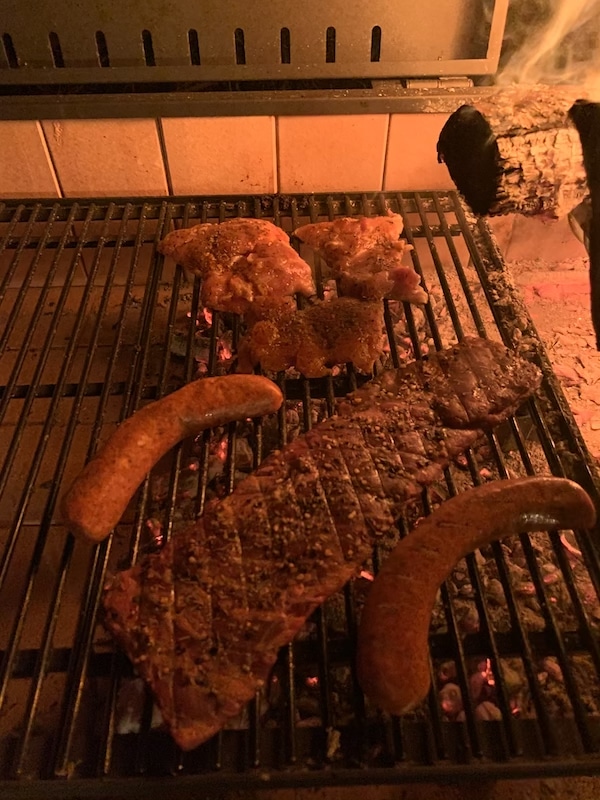
For the second cook, I went for a more typical Argentinian asado with dry-brined skirt steak, a few chorizo links (read our tips on grilling sausages here), and some wet-brined chicken thighs (here’s our complete guide to wet brining). I also threw sliced peppers and onions on there. Again, everything tasted amazing, even with minimal seasoning, a tribute to wood-fired cooking in general (sorry I couldn’t get a better photo; it was dark at dinnertime). If you’re a fire lover, this is a fun way to grill…tongs in one hand, fire poker in the other, a beer nearby…you spend as much time managing the fire as the food and that’s half the thrill of it.

Griddle test
After cooking a few other meats in a similar way, it was time to test the griddle or “chapa.” One gloriously sunny morning, I made breakfast on it. I par-cooked some new potatoes inside while the Delta was preheating, then wandered outside with a tray full of ingredients and started sizzling some bacon in the pan. When the fat rendered, I smashed the potatoes in the bacon fat and cracked a couple eggs in too. A few slices of homemade sourdough also went into the fat to toast, and everything cooked beautifully over the small wood fire in the firebox.
The chapa has a 3/4-inch lip all around it to retain fats and juices, so it’s like a griddle and sheet pan in one. (Check out our complete guide to griddle grilling here). You can saute vegetables or shrimp right over the fire, or use it any way you would use a saute pan. Standing there cooking breakfast, I was dreaming of making a Detroit-style pizza in the chapa to get that delicious frico from the cheese melting and browning on the hot steel.
Future tests
“If you preheated a pizza stone on the grill grate using the hot embers,” I thought, “you could clear out the embers, then slide the chapa full of Detroit pizza onto the firepit floor and close the lid, and the pizza stone above would radiate heat to the top of the pizza to finish cooking the dough and melt the cheese.” I haven’t tried it yet, but I will. The Delta’s firebrick floor is essentially like the deck of a wood-fired pizza oven, so I’m also dreaming of a Neapolitan style pizza baked right there on the hot firebricks with a preheated pizza stone above on the grill grate. When I get around to these pizza tests, I’ll update the review.
Clean Up
Cleaning the Delta is a simple matter of shoveling out the ashes with the provided shovel. I noticed some grease spots on the firebricks here and there but I had zero issues with grease fires or grease running over the firebricks and pooling beneath them.

I did notice that some ash shuffled down through the cutouts on the firebricks near the grill assembly and into the warming drawer below. No big deal, but you may want to periodically check the drawer in that spot to clean out any ashes.
Assembly
ÑukeBBQUSA does a great job packing up the Delta for shipping, but even so, it arrived with some minor cosmetic damage such as cracked wood on the bottom of the cart shelf.
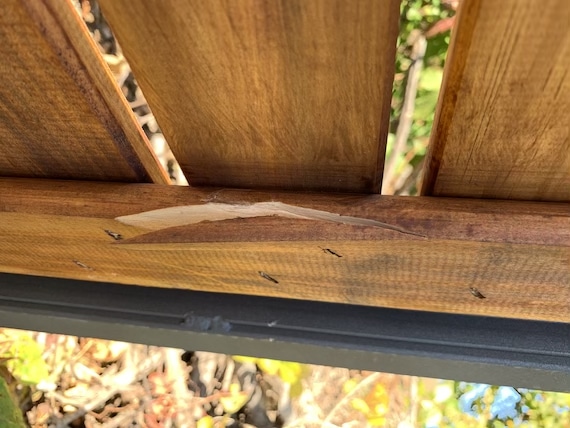
With the rolling cart, the whole thing weighs 265 pounds, so you need a helping hand assembling it. Once the Delta is set on the cart, a single person can do the rest. All you need is a socket wrench, a pair of pliers, and maybe a file. My grill grates didn’t quite fit into the frame, so I had to file down one side to get the grates to lay flat.
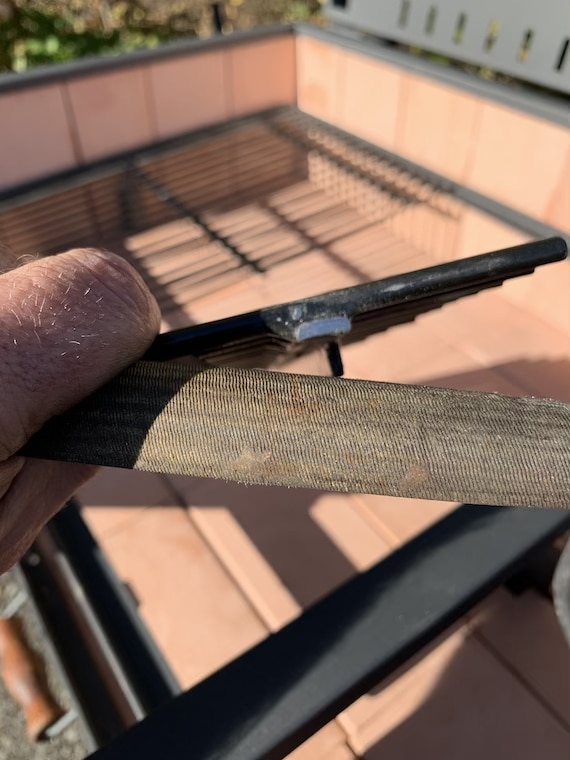
One of the grate rods also didn’t sit flat because it popped loose from the weld. I didn’t feel like welding it back into place, so I just left it.
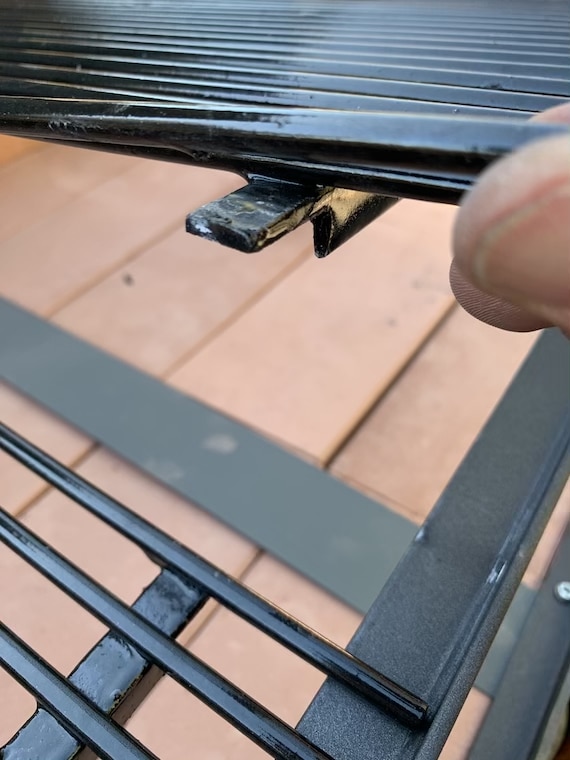
There is a short metal lip or “ember protector” that runs across the front of the firepit. The assembly manual says you have to install the ember protector by screwing it into the frame. Mine came already pre-installed. Yay! The manual also says to screw in the thermometer, but mine was pre-installed, and the thermometer arrived with a small crack in the glass. Boo!

It’s just a cosmetic crack, and all these bi-metal dial thermometers are cosmetic “heat indicators” anyway, so I didn’t mind much. If you really want to look at numbers when you’re grilling, get yourself a reliable digital thermometer or two. You’ll never look back. Read here about why you need a digital thermometer.
I noticed that one of the rivets popped up on the door hinge of the warming drawer.

One of the firebricks also cracked in transit.
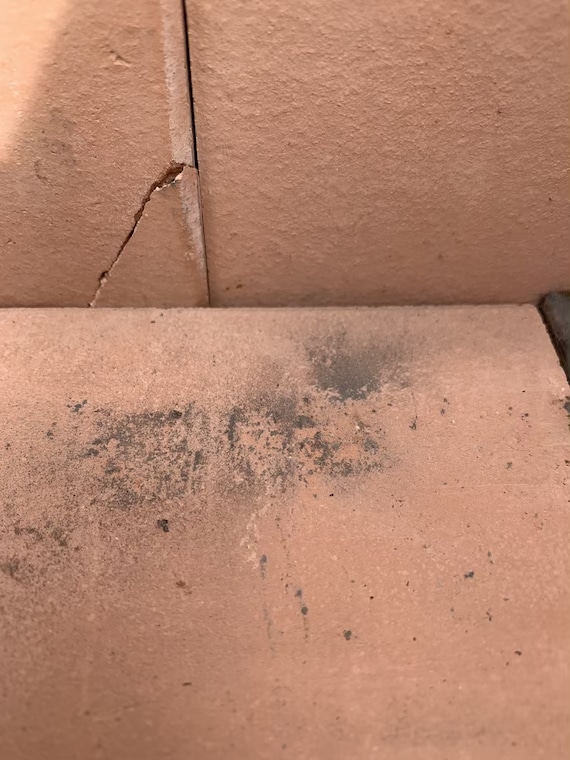
No Big Deal!
But Ñuke ships the Delta with a few spare firebricks so, again, no big deal. And the rolling cart doesn’t have locking casters, so it can slide around some. Find a spot with level ground!
None of these minor imperfections affected performance at all. But when you’re paying over $1000 for a grill, you might expect everything to be perfect. So I called Ñuke’s customer service line and was very impressed with their response. They said they pack their grills as securely as possible to ship from Argentina. But sometimes, despite all their packing materials, minor damage can happen in transit from South America. In the case of any damage, Ñuke will ship out a replacement handle, wood slat, thermometer, or other part if the part arrives cracked, at no charge of course. They have even shipped paint to fix a minor scratch. If you have any problem with your grill when it arrives, Ñuke’s customer service will take care of you.
Up your game: Join our Pitmaster Club. Try it out for free for 30 days. No credit card is needed. No spam. Join now and Be Amazing!
Conclusion
You might be surprised by the price of other grills in this category…they usually run into the thousands—if not tens of thousands—of dollars. GrillWorks makes some fantastic (and fantastically expensive) rigs used by high-end chefs like Dan Barber at Blue Hill at Stone Barns in New York. Other companies like Gaucho Grills, Urban Asado, and Norcal Oven Works make similar but smaller and less expensive versions. Engelbrecht also makes some affordable stripped-down Santa Maria-style grills, many of which include the typical Argentinian angled and channeled V-grates. But the Delta is cheaper than all those. And it comes with a full-length vinyl weather cover, a 30-inch fire poker, a 30-inch shovel, and 19 5/8 by 9 5/8-inch carbon-steel griddle.
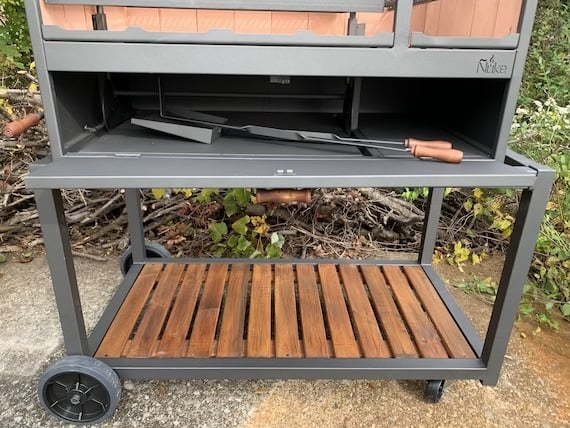
Ñuke sells an even cheaper model called the Pampa with a much smaller grill area. It also has no warming drawer, no firebox, and no rolling cart. It’s definitely worth it to get the bigger Delta.
Overall build quality is very good here despite the minor quibbles mentioned above. Personally, I would prefer the traditional V-grates to channel dripping meat juices into a tray for basting or sauce. I look forward to checking out Ñuke’s new Puma model. Overall, the Delta succeeds in bringing Argentine-style grilling to a wider audience at a reasonable price point. For the money, this cooker is well worth it and a lot of fun. Just remember the key ingredient when cooking on a gaucho grill: patience. Relax and trust the process.
Warranty
Ñuke warrants against any defects in the manufacturing and workmanship to the original purchaser for a period of one year from date of purchase bearing sales receipt.
We thank ÑukeBBQUSA for providing the Delta for our tests.
Click the buttons below to search our complete database of reviews:
Product Information:
-
Model:The Delta
-
Item Price :1,600.00
*Price Subject To Change -
Where to buy: ** buying from one of these suppliers will help support this website.
-
Review Method:Cooked On It
We have hands-on experience testing this product. We have also gathered info from the manufacturer, owners and other reliable sources. -
Primary Function:Grill, Drop Ins
-
Fuel:Charcoal, Logs
-
Primary Capacity:Mid-Size (about 27 burgers) : 547 square inches
-
Secondary Capacity:188 square inches
Manufacturer:
-
ÑukeBBQUSA
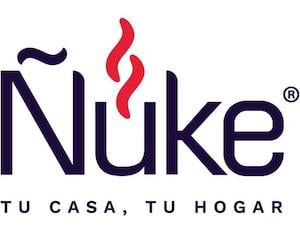
Headquartered in Miami, ÑukeBBQUSA is the exclusive US importer of Ñuke Argentinian-style gaucho grills and wood-fired outdoor ovens. Hand-crafted by Argentinian artisans, the Ñuke lineup brings a modern style and functionality to the centuries-old traditions of grilling on the Argentinian pampas (prairies). Ideal for those who love to play with fire, Ñuke grills bring the authentic flavors and excitement of cooking with real wood or natural charcoal to any backyard or restaurant.
Related reviews
-
Dave Joachim, AmazingRibs.com Editorial Director - Editorial Director of AmazingRibs.com, David Joachim has authored, edited, or collaborated on more than 50 cookbooks, four of them on barbecue and grilling, and his Food Science column appeared in "Fine Cooking" magazine from 2011 to 2019. He’s a perfect match for a website dedicated to the “Science of Barbecue and Grilling.”
Up Your BBQ IQ By Joining The Pitmaster Club

Sign up for a free trial of the AmazingRibs.com Pitmaster Club and experience everything that the world’s largest membership-based BBQ and grilling community has to offer!
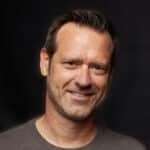
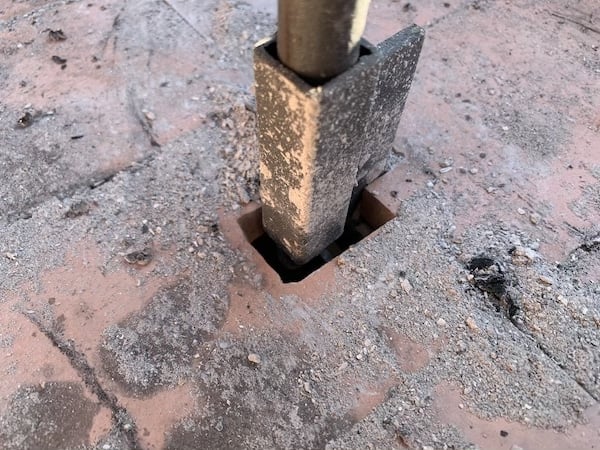
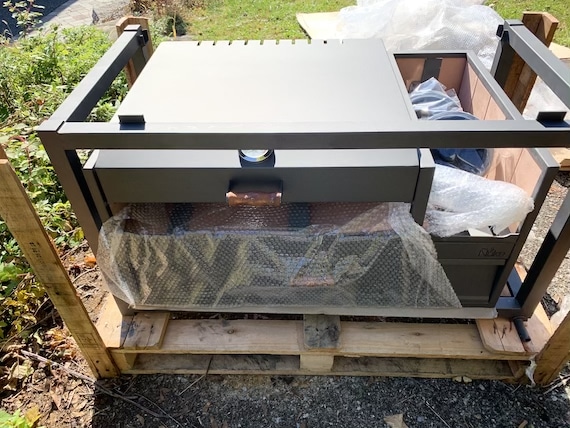
High quality websites are expensive to run. If you help us, we’ll pay you back bigtime with an ad-free experience and a lot of freebies!
Millions come to AmazingRibs.com every month for high quality tested recipes, tips on technique, science, mythbusting, product reviews, and inspiration. But it is expensive to run a website with more than 2,000 pages and we don’t have a big corporate partner to subsidize us.
Our most important source of sustenance is people who join our Pitmaster Club. But please don’t think of it as a donation. Members get MANY great benefits. We block all third-party ads, we give members free ebooks, magazines, interviews, webinars, more recipes, a monthly sweepstakes with prizes worth up to $2,000, discounts on products, and best of all a community of like-minded cooks free of flame wars. Click below to see all the benefits, take a free 30 day trial, and help keep this site alive.
Post comments and questions below
1) Please try the search box at the top of every page before you ask for help.
2) Try to post your question to the appropriate page.
3) Tell us everything we need to know to help such as the type of cooker and thermometer. Dial thermometers are often off by as much as 50°F so if you are not using a good digital thermometer we probably can’t help you with time and temp questions. Please read this article about thermometers.
4) If you are a member of the Pitmaster Club, your comments login is probably different.
5) Posts with links in them may not appear immediately.
Moderators